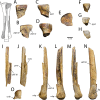A partial oviraptorosaur skeleton suggests low caenagnathid diversity in the Late Cretaceous Nemegt Formation of Mongolia
- PMID: 34252154
- PMCID: PMC8274908
- DOI: 10.1371/journal.pone.0254564
A partial oviraptorosaur skeleton suggests low caenagnathid diversity in the Late Cretaceous Nemegt Formation of Mongolia
Abstract
The Nemegt Formation of the Gobi Desert of Mongolia has produced one of the most abundant and diverse oviraptorosaur records globally. However, the caenagnathid component of this fauna remains poorly known. Two caenagnathid taxa are currently recognized from the Nemegt Formation: Elmisaurus rarus and Nomingia gobiensis. Because these taxa are known from mostly non-overlapping material, there are concerns that they could represent the same animal. A partial, weathered caenagnathid skeleton discovered adjacent to the holotype quarry of Nomingia gobiensis is referable to Elmisaurus rarus, revealing more of the morphology of the cranium, mandible, pectoral girdle, and pubis. Despite metatarsals clearly exhibiting autapomorphies of Elmisaurus rarus, overlapping elements are identical to those of Nomingia gobiensis, and add to a growing body of evidence that these taxa represent a single morphotype. In the absence of any positive evidence for two caenagnathid taxa in the Nemegt Formation, Nomingia gobiensis is best regarded as a junior synonym of Elmisaurus rarus. Low caenagnathid diversity in the Nemegt Formation may reflect broader coexistence patterns with other oviraptorosaur families, particularly oviraptorids. In contrast to North America, competition with the exceptionally diverse oviraptorids may have restricted caenagnathids to marginal roles in Late Cretaceous Asian ecosystems.
Conflict of interest statement
The authors have declared that no competing interests exist.
Figures








Similar articles
-
A new oviraptorosaur (Dinosauria: Theropoda) from the end-Maastrichtian Hell Creek Formation of North America.PLoS One. 2024 Jan 24;19(1):e0294901. doi: 10.1371/journal.pone.0294901. eCollection 2024. PLoS One. 2024. PMID: 38266012 Free PMC article.
-
A new baby oviraptorid dinosaur (Dinosauria: Theropoda) from the Upper Cretaceous Nemegt Formation of Mongolia.PLoS One. 2019 Feb 6;14(2):e0210867. doi: 10.1371/journal.pone.0210867. eCollection 2019. PLoS One. 2019. PMID: 30726228 Free PMC article.
-
Perinate and eggs of a giant caenagnathid dinosaur from the Late Cretaceous of central China.Nat Commun. 2017 May 9;8:14952. doi: 10.1038/ncomms14952. Nat Commun. 2017. PMID: 28486442 Free PMC article.
-
New specimens of Nemegtomaia from the Baruungoyot and Nemegt Formations (Late Cretaceous) of Mongolia.PLoS One. 2012;7(2):e31330. doi: 10.1371/journal.pone.0031330. Epub 2012 Feb 8. PLoS One. 2012. PMID: 22347465 Free PMC article.
-
A new alvarezsaurid dinosaur from the Nemegt Formation of Mongolia.Sci Rep. 2019 Oct 29;9(1):15493. doi: 10.1038/s41598-019-52021-y. Sci Rep. 2019. PMID: 31664171 Free PMC article.
Cited by
-
Transformation of the pectoral girdle in pennaraptorans: critical steps in the formation of the modern avian shoulder joint.PeerJ. 2024 Feb 29;12:e16960. doi: 10.7717/peerj.16960. eCollection 2024. PeerJ. 2024. PMID: 38436017 Free PMC article.
-
A new oviraptorosaur (Dinosauria: Theropoda) from the end-Maastrichtian Hell Creek Formation of North America.PLoS One. 2024 Jan 24;19(1):e0294901. doi: 10.1371/journal.pone.0294901. eCollection 2024. PLoS One. 2024. PMID: 38266012 Free PMC article.
References
-
- Gradziński R. Sedimentation of dinosaur-bearing Upper Cretaceous deposits of the Nemegt basin, Gobi Desert. Palaeontol Pol. 1970;21: 147–229.
-
- Jerzykiewicz T, Russell DA. Late Mesozoic stratigraphy and vertebrates of the Gobi Basin. Cretac Res. 1991;12: 345–377.
-
- Eberth DA, Badamgarav D, Currie PJ. The Baruungoyot-Nemegt Transition (Upper Cretaceous) at the Nemegt Type Area, Nemegt Basin, South Central Mongolia. J Paleontol Soc Jorea. 2009;25: 1–15.
-
- Eberth DA. Stratigraphy and paleoenvironmental evolution of the dinosaur-rich Baruungoyot-Nemegt succession (Upper Cretaceous), Nemegt Basin, southern Mongolia. Palaeogeogr Palaeoclimatol Palaeoecol. 2018;494: 29–50. doi: 10.1016/j.palaeo.2017.11.018 - DOI
-
- Jerzykiewicz T, Currie PJ, Fanti F, Lefeld J. Lithobiotopes of the Nemegt Gobi Basin. Can J Earth Sci. 2021; cjes-2020-0148. doi: 10.1139/cjes-2020-0148 - DOI
Publication types
MeSH terms
Grants and funding
LinkOut - more resources
Full Text Sources


